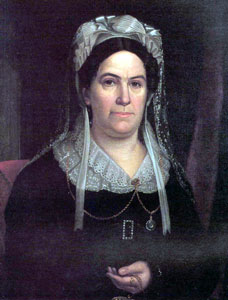
Rachel Donelson Jackson
The daughter of John Donelson and Rachel Stockley and wife of President Andrew Jackson, Rachel Donelson was born in Pittsylvania County, Virginia. In December 1779 her family set out for the West, arriving at Fort Nashborough (now Nashville) in April 1780. The Donelsons originally settled on land bordering Stones River, but a few months later they moved near Harrodsburg, Kentucky, then a part of Virginia. In March 1785, Rachel Donelson married Lewis Robards, a native of Mercer County, Kentucky, and the couple moved in with Robards’s widowed mother.
From the outset the marriage was an unhappy one. According to later accounts, quarrels erupted over the flirtatious nature of the vivacious and beautiful Rachel. By 1788 the Robards had separated, and Rachel moved in with her mother, then living near Nashville.
Efforts at reconciliation failed as Robards observed on occasional visits Rachel’s friendship with Andrew Jackson, a young lawyer from North Carolina now boarding with her mother. By 1790 the Robards had separated permanently, and Rachel visited friends in Natchez to escape further mistreatment by her estranged husband. In December Robards appealed to the Virginia legislature for divorce, and that body remanded the issue to the courts of the Kentucky district. When Jackson learned of the Virginia authorization, he went to Natchez and married Rachel in August 1791, not realizing that Robards had failed to pursue the case. Robards finally took the issue to the Mercer County court in January 1792, charging adultery, and on September 27, 1793, the court granted his petition. On January 18, 1794, Andrew and Rachel remarried before Robert Hays, a Davidson County justice of the peace.
The marriage proved a happy one. The Jacksons had no children, but they adopted her nephew Andrew (1808-1865), cared for several Indian orphans, and served as guardians for numerous children of friends and family. Rachel assisted in managing their farm during Jackson’s absence and took great interest in gardening and in the construction of a new house at the Hermitage. She accompanied her husband on various trips–to Washington in 1815, to New Orleans for celebrations in Jackson’s honor, to Pensacola when he served as Florida governor, and to Washington during his stint as senator in the mid-1820s. But Rachel preferred the farm to city life, and she found peace and security in the scriptures and sermons she read at home and heard at the Presbyterian church on their property. As she aged, she gained weight, developed respiratory illness, and suffered from depression. The presidential campaign of 1828 contributed further to her deteriorating health, as Jackson’s opponents dredged up the unusual circumstance of their marriages to demonstrate his moral flaws. The rumors probably contributed to the development of Rachel’s final illness, which first manifested itself on December 17, 1828, some four weeks before the Jacksons’ scheduled departure for the inauguration. Five days later, on December 22, Rachel died, apparently from a massive heart attack. Her funeral and burial followed in the Hermitage garden she had so carefully maintained over the years. Jackson ordered a tomb constructed for her remains and cherished her memory and virtue until his own death. The account of their love and devotion to each other is legendary even today and is recounted in biographies, film, fiction, drama, and music.
Suggested Reading
Harold D. Moser et al., The Papers of Andrew Jackson, 5 vols. to date (1981- ); Catherine W. Cruse, An Amiable Woman: Rachel Jackson (1994)



